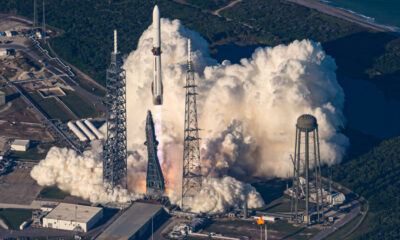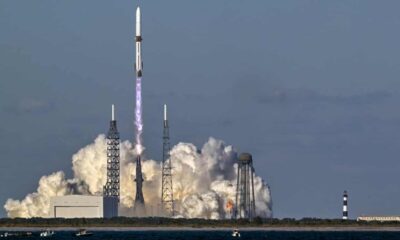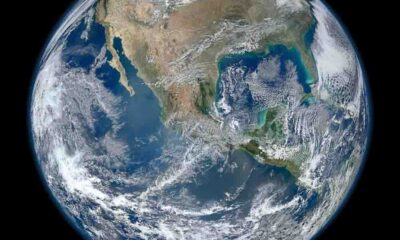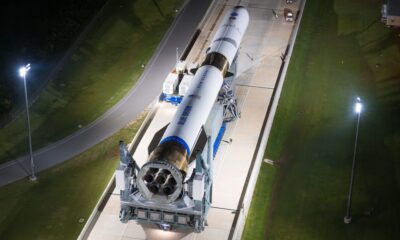Science
NASA’s ESCAPADE Mission Launch Delayed by Solar Storm Activity
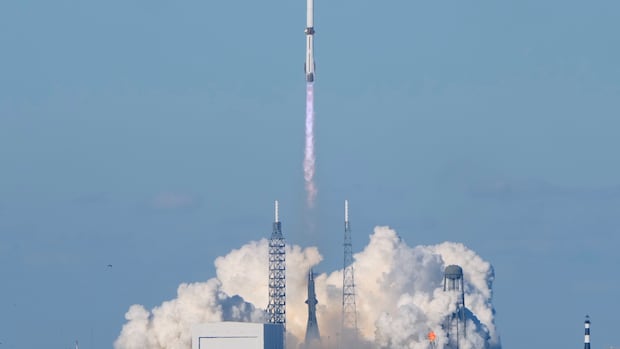
NASA’s ESCAPADE mission, aimed at exploring the effects of solar wind on the Martian atmosphere, faced an unexpected delay due to a solar storm. Originally scheduled for launch on November 12, 2023, aboard a Blue Origin New Glenn rocket, the mission was postponed to November 13 after a significant coronal mass ejection (CME) erupted from the sun. This phenomenon, characterized by large clouds of charged particles, posed a risk of damaging the spacecraft during its ascent.
Coronal mass ejections can unleash particles into space at extraordinary speeds, and the recent event directed a stream of these particles towards Earth. The result was a stunning display of auroras, or Northern Lights, visible to those in the northern hemisphere on the evening of November 11. These lights occur when charged particles interact with Earth’s magnetic field, illuminating the atmosphere near the poles.
Despite the beauty of the auroras, the solar particles can disrupt the delicate electronic systems on spacecraft, leading to malfunctions or failure. Consequently, NASA made the prudent decision to delay the launch until the hazardous conditions subsided. Ironically, the two ESCAPADE spacecraft, which are designed to investigate the very effects of solar activity on Mars, had to remain on the ground due to solar interference on Earth.
The Mysteries of Mars’ Atmosphere
One of the key objectives of the ESCAPADE mission is to unravel the mystery of Mars’ thinning atmosphere. Research indicates that approximately three billion years ago, Mars was a much warmer and wetter planet, potentially supporting rivers, lakes, and even oceans. This raises intriguing questions about the possibility of past life on Mars, although no definitive evidence has been discovered to date.
Since this earlier era, Mars’s atmosphere has diminished to roughly 1/1000th the density of Earth’s, transforming the planet into the barren, desert-like world we see today. Scientists suggest several factors may have contributed to this atmospheric loss. The absence of active volcanic activity, which could replenish the atmosphere, combined with a weakened magnetic field, allowed solar wind to penetrate deeper and strip away air molecules.
Earth benefits from both a dynamic geological environment and a robust magnetic field, which together provide a protective shield against solar activity. In contrast, Mars has not experienced similar protection, making it vulnerable to the effects of solar eruptions.
Future Implications for Mars Exploration
ESCAPADE consists of two spacecraft that will orbit Mars, monitoring solar activity and its impact on the Martian atmosphere. This research is vital for understanding the current rate of atmospheric loss on Mars, which has significant implications for future human missions. Astronauts on the Martian surface will face increased exposure to solar radiation, making it essential to comprehend how this radiation interacts with the atmosphere.
Recent studies conducted by scientists in the Netherlands have revealed that other planets may also be susceptible to atmospheric loss due to powerful solar eruptions. They discovered a coronal mass ejection from a red dwarf star that was hundreds of times more intense than those from our sun. This raises concerns that planets orbiting such stars could lose their atmospheres entirely, reducing the likelihood of finding habitable conditions elsewhere in the universe.
As researchers continue to investigate these phenomena, it underscores the delicate balance of life on Earth and the challenges faced by other planets. The ESCAPADE mission, while delayed, represents an important step towards understanding not only Mars but also the broader implications for planetary atmospheres throughout our galaxy.
-

 Politics1 week ago
Politics1 week agoSecwepemc First Nation Seeks Aboriginal Title Over Kamloops Area
-

 World4 months ago
World4 months agoScientists Unearth Ancient Antarctic Ice to Unlock Climate Secrets
-

 Entertainment4 months ago
Entertainment4 months agoTrump and McCormick to Announce $70 Billion Energy Investments
-

 Lifestyle4 months ago
Lifestyle4 months agoTransLink Launches Food Truck Program to Boost Revenue in Vancouver
-

 Science4 months ago
Science4 months agoFour Astronauts Return to Earth After International Space Station Mission
-

 Technology3 months ago
Technology3 months agoApple Notes Enhances Functionality with Markdown Support in macOS 26
-

 Top Stories1 month ago
Top Stories1 month agoUrgent Update: Fatal Crash on Highway 99 Claims Life of Pitt Meadows Man
-

 Sports4 months ago
Sports4 months agoSearch Underway for Missing Hunter Amid Hokkaido Bear Emergency
-

 Politics3 months ago
Politics3 months agoUkrainian Tennis Star Elina Svitolina Faces Death Threats Online
-

 Politics4 months ago
Politics4 months agoCarney Engages First Nations Leaders at Development Law Summit
-

 Technology4 months ago
Technology4 months agoFrosthaven Launches Early Access on July 31, 2025
-

 Top Stories3 weeks ago
Top Stories3 weeks agoFamily Remembers Beverley Rowbotham 25 Years After Murder

